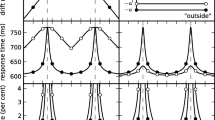Abstract
This paper focuses on automatic number processing as instantiated in the size congruity effect. It was recently argued that long-term “associations between individual digits and the attributes ‘small’ and ‘large’ create the size congruity effect” (Choplin and Logan 2003, abstract, p. 17). Moreover, these authors proposed the additional assumption that the relevant connections are acquired over a lifetime of experience with numbers. We show that at least one of these assumptions is not true: either the size congruity effect derives from an (online) comparison effect between two numbers at the time of stimulus presentation (violating the first assumption) or the relevant connections flexibly change (offline) between trials during the course of one experimental session (violating the second assumption).

Similar content being viewed by others
Notes
Other researchers already obtained size congruity effects with single digits (e.g., Algom, Dekel, & Pansky, 1996; Schwarz & Ischebeck, 2000; Tzelgov et al., 1992), but in their experiments, trials on which numerical size was irrelevant were always mixed with trials on which it was relevant (either blocked or not). On the relevant trials, participants were instructed to compare the numerical size of the presented digit with the numerical size of a fixed standard. Because of this, one could argue that participants continued engaging in a numerical comparison with the standard on the irrelevant trials, despite the instruction to respond on the basis of physical size.
The interaction test between response (small/large) and number (4/5) is equivalent to a contrast that assigns a weight of +1 to the two “response = small, number = 4” conditions and the two “response = large, number = 5” conditions, and a weight of -1 to the other four conditions. Alternatively, the eight conditions can be rearranged in a congruity (congruent/incongruent) × distance (small/large) × response (small/large) format. The interaction between congruity and distance is equivalent to a contrast that assigns a weight of +1 to the two “congruity = incongruent, distance = small” conditions and to the two “congruity = congruent, distance = large” conditions, and a weight of −1 to the other four conditions. The weight assignments are equivalent for the two situations, and therefore the response × number and congruity × distance interactions are equivalent.
References
Algom D., Dekel A., & Pansky, A. (1996). The perception of number from the separability of the stimulus: The Stroop effect revisited. Memory & Cognition, 24, 557–572.
Choplin, J. M. & Logan, G. D. (2003). Automaticity of number perception. In R. Alterman, & D. Kirsh (Eds), Proceedings of the Twenty-fifth Annual Conference of the Cognitive Science Society, 252–257.
Choplin, J. M., & Logan, G. D. (2005). A memory-based account of automatic numerosity processing. Memory & Cognition, 33, 17–28.
Dehaene, S., Bossini, S., & Giraux, P. (1993). The mental representation of parity and number magnitude. Journal of Experimental Psychology: General, 122, 371–396.
Fias, W., Brysbaert, M., Geypens, F., & d’Ydewalle, G. (1996). The importance of magnitude information in numerical processing: Evidence from the SNARC effect. Mathematical Cognition, 2, 95–110.
Gevers, W., Caessens, B., & Fias, W. (2005). Towards a common processing architecture underlying Simon and SNARC effects. European Journal of Cognitive Psychology, 17, 659–673.
Gevers, W., Ratinckx, E., De Baene, W., & Fias, W. (2006a). Implicit number–space links activate spatial responses: Evidence from the LRP. Experimental Psychology, 53, 58–68.
Gevers, W., Verguts, T., Reynvoet, B., Caessens, B., & Fias, W. (2006b). Numbers and space: A computational model of the SNARC effect. Journal of Experimental Psychology: Human Perception and Performance, 32, 32–44.
Henik, A., & Tzelgov, J. (1982). Is three greater than five: The relation between physical and semantic size in comparison tasks. Memory & Cognition, 10, 389–395.
Lammertyn, J., & Fias, W. (2005). Negative priming with numbers: No evidence for a semantic locus. Quarterly Journal of Experimental Psychology: A, 58, 1153–1172.
Leth-Steensen, C., & Marley, A. A. J. (2000). A model of response time effects in symbolic comparison. Psychological Review, 107, 62–100.
Logan, G. D. (1988). Toward an instance theory of automatization. Psychological Review, 95, 492–527.
Moors, A., & De Houwer, J. (2006). Automaticity: A theoretical and conceptual analysis. Psychological Bulletin, 132, 297–326.
Moyer, R. S., & Landauer, T. K. (1967). Time required for judgments of numerical inequality. Nature, 215, 1519–1520.
Naccache, L., & Dehaene, S. (2001). Unconscious semantic priming extends to novel unseen stimuli. Cognition, 80, 215–229.
Pansky, A., & Algom, D. (1999). Stroop and Garner effects in comparative judgment of numerals: The role of attention. Journal of Experimental Psychology: Human Perception and Performance, 25, 39–58.
Schwarz, W., & Heinze, H. J. (1998). On the interaction of numerical and size information in digit comparison: A behavioral and event-related potential study. Neuropsychologia, 36, 1167–1179.
Schwarz, W., & Ischebeck, A. (2000). Sequential effects in number comparison. Journal of Experimental Psychology: Human Perception and Performance, 26, 1606–1621.
Sergent, C., & Dehaene, S. (2004). Is consciousness a gradual phenomenon? Evidence for an all-or-none bifurcation during the attentional blink. Psychological Science, 15, 720–728.
Tzelgov, J., Meyer, J., & Henik, A. (1992). Automatic and intentional processing of numerical information. Journal of Experimental Psychology: Learning, Memory, and Cognition, 18, 166–179.
Verguts, T., Fias, W., & Stevens, M. (2005). A model of exact small-number representation. Psychonomic Bulletin & Review, 12, 66–80.
Acknowledgments
The authors want to thank Jan De Houwer for helpful suggestions. WF is supported by the Inter University Attraction Pole P5/05 (Belgian Government) and by a GOA grant from the Ghent University Research Fund. The contribution of FVO and TV was supported by grant G.0188.04 from the Fund of Scientific Research—Flanders
Author information
Authors and Affiliations
Corresponding author
Additional information
An erratum to this article can be found at http://dx.doi.org/10.1007/s00426-007-0119-1
Rights and permissions
About this article
Cite this article
Van Opstal, F., Moors, A., Fias, W. et al. Offline and online automatic number comparison. Psychological Research 72, 347–352 (2008). https://doi.org/10.1007/s00426-007-0108-4
Received:
Accepted:
Published:
Issue Date:
DOI: https://doi.org/10.1007/s00426-007-0108-4




